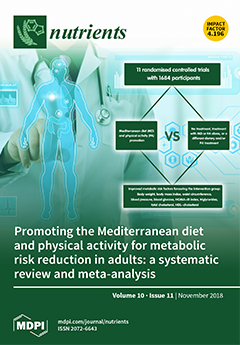Objective: Contrary to the concerns that fructose may have adverse metabolic effects, an emerging literature has shown that small doses (≤10 g/meal) of fructose and its low-caloric epimers (allulose, tagatose, and sorbose) decrease the glycemic response to high glycemic index meals. Whether these acute reductions manifest as sustainable improvements in glycemic control is unclear. Our objective was to synthesize the evidence from controlled feeding trials that assessed the effect of small doses of fructose and its low-caloric epimers on glycemic control.
Methods: We searched MEDLINE, EMBASE, and the Cochrane Library through April 18, 2018. We included controlled feeding trials of ≥1 week that investigated the effect of small doses (≤50 g/day or ≤10% of total energy intake/day) of fructose and its low-caloric epimers on HbA
1c, fasting glucose, and fasting insulin. Two independent reviewers extracted data and assessed risk of bias. Data were pooled using the generic inverse variance method and expressed as mean differences (MDs) with 95% confidence intervals (CIs). Heterogeneity was assessed using the Cochran Q statistic and quantified using the
I2 statistic. Grading of Recommendations Assessment, Development and Evaluation (GRADE) assessed the certainty of the evidence.
Results: We identified 14 trial comparisons (
N = 337) of the effect of fructose in individuals with and without diabetes, 3 trial comparisons (
N = 138) of the effect of allulose in individuals without diabetes, 3 trial comparisons (
N = 376) of the effect of tagatose mainly in individuals with type 2 diabetes, and 0 trial comparisons of the effect of sorbose. Small doses of fructose and tagatose significantly reduced HbA
1c (MD = −0.38% (95% CI: −0.64%, −0.13%); MD = −0.20% (95% CI: −0.34%, −0.06%)) and fasting glucose (MD = −0.13 mmol/L (95% CI: −0.24 mmol/L, −0.03 mmol/L)); MD = −0.30 mmol/L (95% CI: −0.57 mmol/L, −0.04 mmol/L)) without affecting fasting insulin (
p > 0.05). Small doses of allulose did not have a significant effect on HbA
1c and fasting insulin (
p > 0.05), while the reduction in fasting glucose was of borderline significance (
p = 0.05). The certainty of the evidence of the effect of small doses of fructose and allulose on HbA
1c, fasting glucose, and fasting insulin was graded as low. The certainty of the evidence of the effect of tagatose on HbA
1c, fasting glucose, and fasting insulin was graded as moderate.
Conclusions: Our results indicate that small doses of fructose and tagatose may improve glycemic control over the long term. There is a need for long-term randomized controlled trials for all four sugars to improve our certainty in the estimates.
Full article






